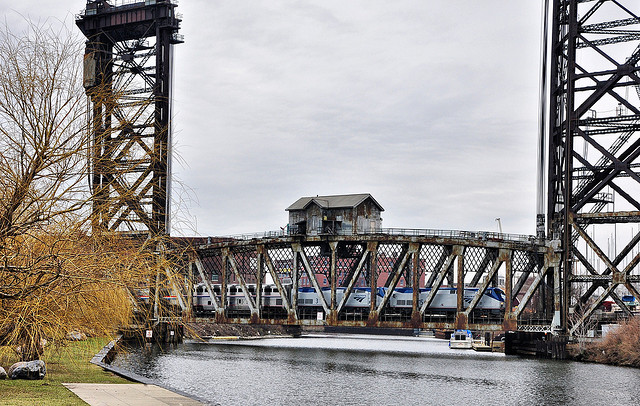Happy 100th Birthday To The Oldest Vertical Lift Bridge In Chicago
By Chuck Sudo in News on Mar 10, 2015 5:30PM
One of Chicago's most photogenic bridges is celebrating a milestone this year. The vertical lift bridge spanning the Chicago River in Chinatown, south of Ping Tom Memorial Park, was built in 1915 for the Pennsylvania Railroad. Today it allows Metra and Amtrak trains to cross the river and is a sight to behold when the bridge is moved.
This was the second vertical lift bridge built in Chicago and the only one remaining. Patrick McBriarty, who wrote the book Chicago River Bridges had this to say about the bridge's details:
The bridge, which crosses the river at an angle of approximately 47 degrees, is designed with a skewed, rivet construction, Pratt truss roadway carrying double-tracks over the waterway. The weight of the moving span, tracks, operating equipment, and bridge house is approximately 1,600 tons. The bridge is 272-feet 10-inches long from center-to-center of the end posts and just over 30-feet wide. The massive steel towers are 185-feet high, host walkways around the top of each, and allow the bridge to open to a maximum river clearance of 111 feet.This vertical-lift bridge operates like an elevator employing sixty-four 2-1/4 inch steel cables, eight on each corner connected with the top of the steel truss roadway and run over eight, 15-foot diameter, cast steel sheaves (or pulleys) atop the adjoining steel towers connecting to massive concrete counterweights suspended above the approaches. So balanced the bridge is operated by two (No. 162 Westinghouse railway type) 220-volt, 300-h.p. motors geared to four cast steel operating drums employing 1-1/8 inch steel operating ropes. Either motor can safely operate the drive mechanism, which includes a 50-h.p. gasoline powered emergency engine capable of lifting the bridge to its maximum height in approximately ten minutes.
The bridge these days is operated by remote control from a railroad switching tower a few blocks north. When a train is crossing, boaters looking to reach Lake Michigan can sometimes wait nearly an hour for the train to cross and the bridge to lift to continue their treks to open water.
